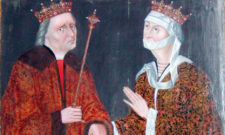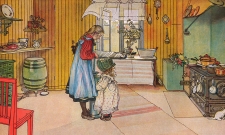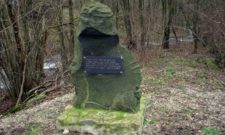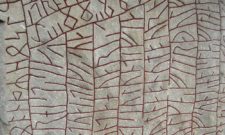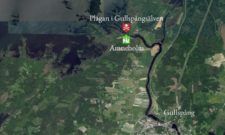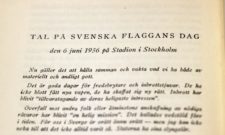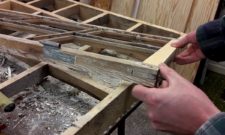Shop our historical maps
History
The first Swedes

Apr
It's rare to have reason to recommend an SVT documentary, but all the more fun when it happens. Right now, anyone who wants to can go to svtplay.se and watch a miniseries called "The First Swedes", consisting of two documentaries that describe how the land that is now Sweden was populated.
This two-part documentary from SVT depicts some of the most fascinating traces of Swedish antiquity, and as far as I can tell, the producers have actually taken care to stick to the correct presentation of the facts.
Below I give a brief summary of the content - the story of how our ancestors took possession of the Scandinavian Peninsula.
Part 1: The Pioneers
80,000 years ago, people began migrating from Africa. By the time the descendants of these people reached northern Europe, their genes had begun to change. They were still dark-skinned, but their eyes were blue.
As the ice sheet melted away, hunters came to Swedish territory on hunting expeditions. Above all, they hunted reindeer grazing on the tundra. About 11 000 years ago, the population began to stay all year round. What we know about these people is that they fished and used flint tools.
The population spread rapidly along the Norwegian coast, where traces of more advanced tools and weapons can also be seen. At the same time, Norway was also populated from the north, from areas that today belong to Russia. Along the Norwegian coast, two arms of humanity, separated thousands of years earlier, thus met. The eastern people also made their living mainly from hunting, but they also brought with them a more complex culture. They had better weapons, made ritual objects and buried their dead. Eastern hunters were fair-skinned and had a greater variety of hair and eye colours. They spread further and further south along the coast of Norway and came to mix with the old hunter population. This merging of the two peoples reached all the way down to Sweden, making Scandinavia the most mixed population in Europe at this time.
The ice sheet retreated further and further. At that time there were about 3000 inhabitants in Sweden. The Österöd woman, a 10,200-year-old female skeleton found outside Lysekil, is the oldest complete skeletal find made in Sweden. The Österöd woman probably had roughly equal amounts of genetic material from the eastern and western hunters. Wear and tear damage to the skeleton indicates that she used her body for heavy physical work. Surprisingly, she was about 170 cm tall and had reached the age of 80 when she died. The explanation is that infectious diseases could not spread when the population was so small and isolated.

9,000 years ago there was a warm period, when the climate was about one degree warmer than today. Sweden's population had grown to 10 000 people. Gotland was colonised and the people there lived from seal hunting and fishing. The shallow lakes acted as giant pantries and 60-70% of the diet seems to have consisted of fish. At the same time, we see traces of conflicts that arose when lakes grew again. The Hunter Stone Age appears to have been a brutal time, when disputes and territorial struggles were often resolved by killing.
8200 years ago, the climate became colder. Lake Agassiz in Canada, which had been icebound, flowed into the Atlantic and the Gulf Stream was affected in such a way that the temperature dropped a few degrees. Winters became longer, the population of Scandinavia found it harder to make a living and perhaps Gotland was depopulated altogether. The cold lasted for 150 years.
7000 years ago, the temperature rose again, and noble forests began to spread across Swedish territory. The population grew and by the end of the Palaeolithic, 30,000 people lived in what would become our country, spread out from north to south. People became more settled and rock carvings appear as evidence of living conditions. Vessels were made from burnt clay and religion included hunting rituals.
6,000 years ago there were major changes. In present-day Sweden, people began to cultivate the land and we entered the Neolithic Age. This was the result of a third wave of migration, made up of people from modern-day Turkey. They were fair-skinned and brought with them livestock such as cows, goats and pigs. During the Neolithic period, the population of southern Sweden increased fivefold and the population of Sweden as a whole rose to around 50 000 individuals. Flint mines were established and flint axes became common tools. However, it is not certain that farmers were better off than hunters. Skeletal evidence from this period shows that they often had an inadequate diet and poor dental health. In addition, society was unequal and seems to have been organised around chiefdoms. A large number of archaeological finds show that the agricultural population sacrificed to the gods. In addition to flint axes, people were sacrificed in lakes and bogs.

The Scandinavian hunters do not seem to have been inclined to adopt the agricultural culture, but continued to maintain their lifestyle. The two peoples (the older hunter culture and the more recent farmer culture) seem to have lived as neighbours without intermingling to any great extent for 600 years.
In today's Swedish population, genetic material from both the hunting culture and the farming culture still survives.
Part 2: The Sea Warriors
5000 years ago, most of Sweden had been populated. Around this time, the next wave of people arrived on the European continent, this time on horses and chariots. They came from the Black Sea area and have in modern times been called yamnaya (in Sweden often jamnaja or the jamna people, my note). Many of them were originally shepherds from present-day Ukraine.
The Yamnaya culture included warrior groups and conflicts arose with the older Europeans. Diseases also spread, including plague. In parts of Europe, the Yamnaya crowded out the earlier population. In addition, the landscape changed as the Yamnaya burned down forested areas to create pasture.
The immigration of yamnaya to Scandinavia was not as massive as in the southern parts of Europe. They came to Sweden from the east, via the Baltic States and Finland. The design of the ceramic objects they produced bears witness to this. Their handicraft production was also characterised by battle axes, which is why the Yamnaya culture in Sweden is known as the battle-axe culture. They brought beer-making to our part of the world, as can be seen from analysis of the contents of the cups that accompanied the dead in their tombs.
Over time, hunters and farmers disappeared into the yamnaya culture. Most people living in Sweden today carry a small amount of genetic material from the hunters and farmers, while most of our DNA comes from the yamnaya. Among other things, the yamnaya carried genes that lead to long stature and lactose tolerance. They also brought with them an Indo-European language, from which we can still recognise certain words, such as numbers.

The Stone Age gave way to the Bronze Age, which lasted for 1500 years. Shields, belt plates, jewellery and ornaments were made. Trade developed and international contacts increased. The petroglyphs in Tanum have provided us with thousands of images that tell us about the life and imaginations of the time. The Swedes of the time were a seafaring people and perhaps the west coast was the site of an entire shipbuilding industry. Reconstructions made after the discovery of ships have shown that they could be loaded with up to a ton and hold 20 people. The petroglyphs also show images of different kinds of weapons and there is much evidence that the Bronze Age was a time of war.
Alongside bronze objects, woollen fabrics became more common. Small garments, such as snow skirts, were made in Sweden, while larger fabrics were imported. In order to buy both metals and cloth, amber and slaves were probably traded.
As research develops new knowledge, Bronze Age society is emerging as increasingly advanced. There appear to have been small kingdoms with professional soldiers in several places in Sweden. Perhaps this power structure led to regular wars. In the Tollense valley in Germany, the remains of a battlefield have been found, where a major clash took place. Among the weapons are bows, wooden clubs and a few swords. From all indications, the structure of Viking society was already established in the Bronze Age. In addition, the religion of the Bronze Age people included figures of the gods who were later worshipped during the Viking Age, and many of the myths of Norse mythology date back to this period.
In conclusion, the legacy of the Nordic Stone Age and Bronze Age lives on today, in our genes as well as in our language and cultural heritage.
Originally published on Cultural memory.
Subscribe to YouTube:
If you appreciate Allmogens independent work to portray our fine Swedish history and Nordic culture, you are welcome to buy something nice in the shop or support us with a voluntary donation. Thank you in advance!
Support Allmogens via Swish: 123 258 97 29
Support Allmogens by becoming a member
Support Allmogens in your will
